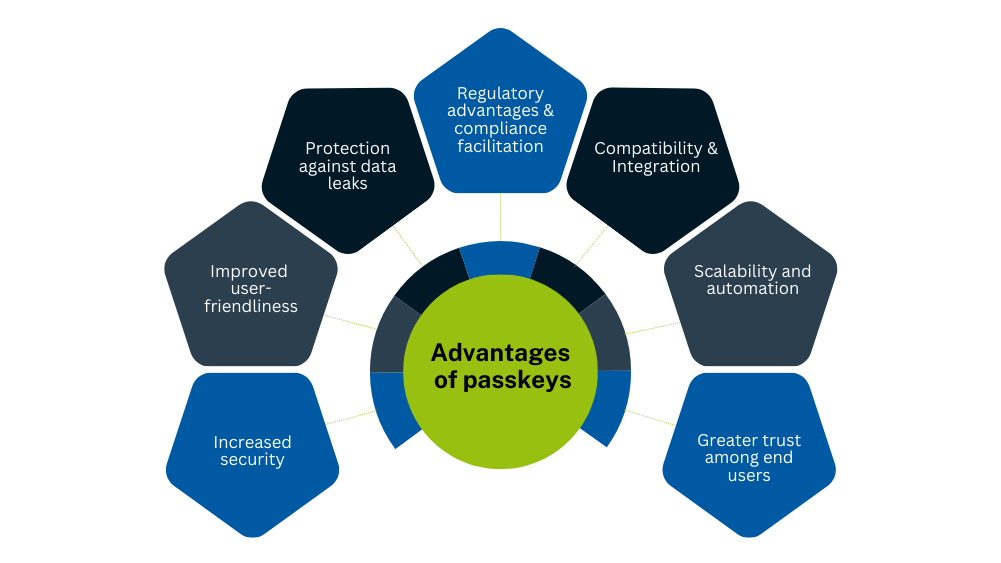Digital authentication is a central component of any security architecture. In many companies, login procedures are still based on traditional passwords, despite their well-known weaknesses: they are forgotten, reused, poorly chosen, or compromised. The result: security risks, high support costs, and declining user satisfaction.
Passkeys offer a modern, secure, and user-friendly alternative that not only addresses the weaknesses of passwords but also sets new standards for authentication.
What are passkeys?
Passkeys replace the traditional password with a digital key pair:
- The public key is stored securely on the service provider's server.
- The private key remains exclusively on the user's device (e.g., smartphone, laptop) and is never transmitted.
When logging in, a challenge is sent from the server to the device. The device signs the request with the private key. The server can then confirm the identity using the public key without the need to enter or transmit a password.
Technologically, this process is based on the open standard FIDO2 and the WebAuthn protocol.
Please also read our article “What are passkeys? An introduction to the passwordless future .”
Overview of the advantages of passkeys

Increased security
Passkeys eliminate many of the most common vulnerabilities of traditional password systems:
- Phishing protection: Passkeys only work with the original domain for which they were generated. Phishing websites come to nothing.
- No central password storage: There is no central target for attack, as the private key is only stored locally.
- Immunity to brute force or credential stuffing attacks: The login process cannot be compromised by trial and error.
Improved user-friendliness
The use of passkeys also offers concrete advantages from the user's perspective:
- No need to remember or manage passwords: Login is biometric (e.g. Face ID, fingerprint) or via a PIN.
- Faster login – across platforms: Users can log in to all supported devices within their ecosystem without having to set a new password.
- Less frustration – fewer IT support tickets: The frequent cause of “forgotten passwords” is completely eliminated.
Protection against data leaks
Even in an emergency, such as a server attack, the damage remains manageable:
- A stolen public key is useless to attackers because the private key is not accessible.
- The risk of large-scale data leaks, such as those involving password databases, is significantly reduced.
Regulatory advantages & easier compliance
Passkeys make it much easier to comply with security and data protection requirements:
- Avoidance of personal password storage: Local storage of the private key on the end device significantly reduces data protection risks – e.g., in the context of the GDPR.
- Traceability and integrity: Authentication is device-bound and clearly traceable, which facilitates audit processes.
- Support for certifications: Passkeys can be a useful addition to existing measures under ISO 27001 or TISAX (Trusted Information Security Assessment Exchange).
Compatibility & integration
- Major platforms such as Apple, Google, and Microsoft already support passkeys system-wide.
- Integration into existing IAM and SSO systems (e.g., Microsoft Entra ID, Okta, Ping Identity) is technically possible and increasingly common.
- Cross-platform synchronization, e.g., via iCloud or Google, facilitates rollout even in decentralized work environments.
Scalability and automation
Passkeys can be efficiently integrated into modern, scalable IT infrastructures:
- Automated user management via IAM systems: The assignment, use, and blocking of passkeys can be integrated into modern identity platforms.
- Bring Your Own Device (BYOD) compatible: Passkeys can also be used securely on private devices without security risks due to password sharing.
- Cloud compatible: Passkey-based authentication works smoothly in both on-premises and cloud environments.
Greater trust among end users
A secure and convenient login experience not only increases acceptance but also trust in digital applications:
- Perceived security: Users notice that their data is better protected through biometric authentication.
- No more insecure compromises: The common practice of choosing simple or reused passwords is completely eliminated.
- Greater trust in corporate systems: Especially in external access (e.g., customer or partner portals), passkeys create a secure foundation for digital interaction.
Comparison: Passkeys vs. traditional passwords
| Aspects | Passkeys |
Traditional passwords |
|
Storage |
Locally on the device, no central password archive |
Centrally on servers or in password managers |
|
Authentication type |
Asymmetric cryptography (challenge-response principle) |
Shared secret (e.g., password) |
|
Area vulnerable to attack |
Phishing-resistant, no reuse |
Vulnerable to phishing, brute force, credential stuffing |
|
User-friendliness |
Biometric or PIN-based, no need to remember anything |
Manual entry, memorization effort, reset processes |
|
Loss/Recovery |
Restoration via cloud backup or device replacement |
High cost in case of loss or compromise |
|
Integration |
Modern, IAM-compatible, SSO-capable |
Often manual integration, complex guidelines |
|
Compliance & safety |
Systemically secure, regardless of user behavior |
Risk due to insecure or reused passwords |
Challenges in introducing passkeys
Despite all the advantages, switching to passkeys comes with certain challenges:
- Not yet supported everywhere: Many websites and services currently still work on a password basis.
- Technical requirements: FIDO2-enabled systems and devices are necessary.
- Organizational integration: Awareness, change management, and targeted communication are crucial for acceptance.
Future prospects
The trend is clear: more and more technology providers and platform operators are relying on passkeys, including as part of larger zero-trust architectures.
In the long term, passkeys could become the standard for authentication on the internet, thereby making a significant contribution to cybersecurity.
Conclusion
Passkeys offer a secure, user-friendly, and future-proof alternative to traditional passwords.
They combine:
- The highest security standards based on modern cryptography,
- A significantly better user experience,
- And a clear prospect for integration into existing corporate infrastructures.
For companies, this means:
- Less risk,
- Less effort,
- More efficiency.